Although both belong to the bear family, Polar Bears and Kodiak Bears have some notable differences.
Polar Bears mainly inhabit the Arctic, where they rely on sea ice for hunting. They possess a longer body and neck with a smaller head, and their diet heavily depends on seals. Conversely, Kodiak Bears reside in the Kodiak Archipelago in Alaska, mainly in forested areas. They have a shorter neck and large shoulder muscles and follow an omnivorous diet.
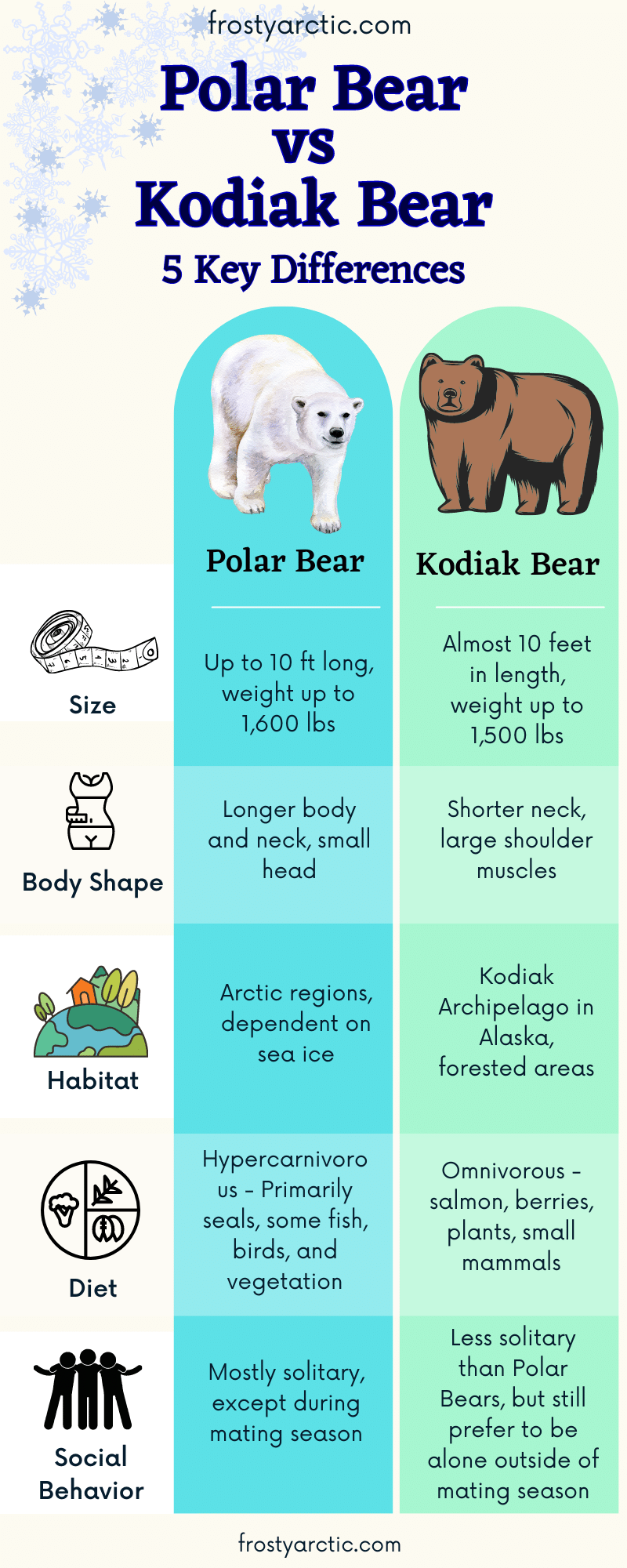
But wait! We’ve only scratched the surface. As the largest members of the bear family, polar bears, and Kodiak bears are powerhouses of the animal kingdom, each beautifully adapted to their specific habitats and lifestyles.
Keep reading to discover more about these awe-inspiring creatures. Our adventure will reveal many more surprising differences between Polar Bears and Kodiak Bears. Trust us, you won’t be disappointed!
Polar Bear vs Kodiak Bear – A Quick Comparison
| Feature | Polar Bear | Kodiak Bear |
| Scientific Name | Ursus maritimus | Ursus arctos middendorffi |
| Body Shape | Longer body and neck, small head | Shorter neck, large shoulder muscles |
| Size | Up to 10 ft long, weight up to 1,600 lbs | Almost 10 feet in length, weight up to 1,500 lbs |
| Diet | Hypercarnivorous – Primarily seals, some fish, birds, and vegetation | Omnivorous – salmon, berries, plants, small mammals |
| Habitat | Arctic regions, dependent on sea ice | Kodiak Archipelago in Alaska, forested areas |
| Social Behavior | Mostly solitary, except during mating season | Less solitary than Polar Bears, but still prefer to be alone outside of mating season |
| IUCN Status | Vulnerable | Least Concern (as part of Brown Bear population) |
Polar Bear vs Kodiak Bear – What Are the Key Differences?
Polar Bears and Kodiak Bears share a common family bond and a few striking similarities.
Both are truly giant beasts capable of reaching incredible sizes. They have adapted wonderfully to their respective icy and woodland territories, relying on their keen sense of smell and strength to hunt. They both live relatively solitary life except during the mating season.
But don’t let these similarities fool you. When you start to scratch beneath the surface, the Polar Bear and the Kodiak Bear each have their own unique features and habits. Let’s look closely and find out who’s who in the bear family!
1. Taxonomy and Scientific Classification
Polar Bear and the Kodiak Bear are both giants in their own right, but did you know that they come from different branches of the bear family tree? Let’s take a look.
Polar Bear
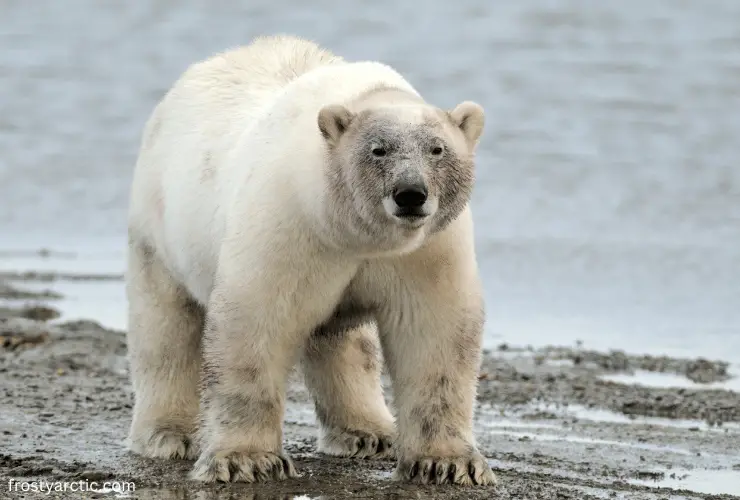
Polar bears are scientifically called Ursus maritimus. The genus ‘Ursus’ means bear, and ‘maritimus’ means maritime, referring to their close association with the sea ice.
These mighty bears are a part of the family Ursidae, subfamily Ursinae. Their closest relative in the bear family is the brown bear, with whom they share the same ancestor.
Interestingly, genetic studies disclose that the polar bear is a relatively new species, having diverged from brown bears roughly 500,000 to 600,000 years ago.
Kodiak Bear
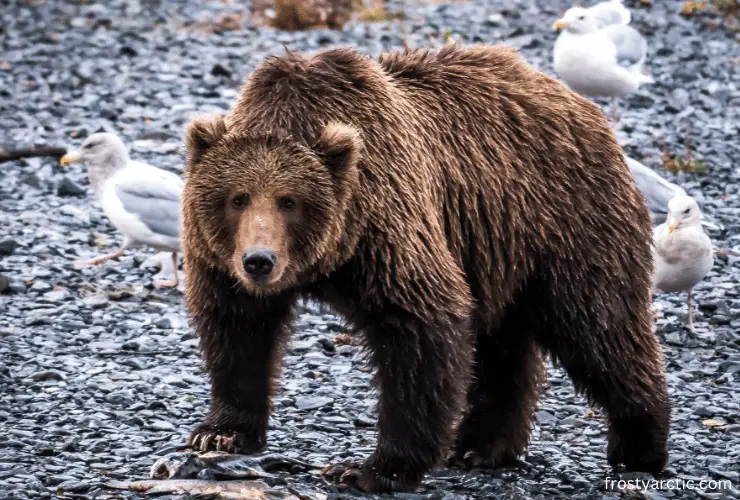
Kodiak bears are scientifically named Ursus arctos middendorffi. These bears also belong to the family Ursidae and subfamily Ursinae. They are a subspecies of the brown bear (Ursus arctos) named after the islands they inhabit.
The Kodiak bear is believed to have branched from the brown bear family roughly 12000 years ago after getting geographically separated at the end of the last ice age, as described by the U.S. Fish & Wildlife Service.
| Taxonomy | Polar Bear | Kodiak Bear |
| Scientific Name | Ursus maritimus | Ursus arctos middendorffi |
| Family | Ursidae | Ursidae |
| Genus | Ursus | Ursus |
| Subfamily | Ursinae | Ursinae |
| Species | maritimus | arctos |
2. Habitat and Distribution
These closely related species live in very different habitats well-suited to their different lifestyles and dietary needs.
Polar Bear
According to the World Wildlife Fund, Polar bears live in the cool Arctic, a region located in the northmost part of the Earth.
They are widely distributed across Arctic regions, including the
- United States (Alaska)
- Canada
- Russia
- Greenland
- Some parts of Norway (Svalbard).
These frosty bears are most commonly found along the coasts and on the sea ice in these regions. A less dense population also occupies the sea ice off the east coast of Greenland and the northern islands of the Norwegian archipelago.
Essentially, for the Polar bear, ‘home’ is wherever the sea ice is!
Kodiak Bear
Kodiak bears solely live in the Kodiak Archipelago, a group of islands in Alaska. This region is rich in rivers, forests, and of course, salmon!
They thrive in the lush, forested areas of the islands and the surrounding coastal areas. These bears are known as the ‘Gentle Giant’ of the Kodiak Archipelago.
| Distribution | Polar Bear | Kodiak Bear |
| Habitat | Arctic regions along coasts and on sea ice | Kodiak Archipelago, Alaska |
| Countries Found | USA (Alaska), Canada, Russia, Greenland, Norway (Svalbard) | USA (Alaska) |
| Preferred Habitat | Sea ice | Forested areas and coasts |
3. Physical Appearance
While both are members of the bear family, these bears are distinguished by several physical characteristics.
Polar Bear

Polar bears are renowned for their distinctive white fur, which helps them blend into icy surroundings. But did you know their fur isn’t actually white? It’s transparent and hollow, which scatters and reflects light, making it appear white. Interesting, right?
Polar bears are large. Males can weigh around 900 to 1600 pounds and can be up to 8 to 10 feet long.
Their bodies are longer and leaner than other bears. They have a pointed snout and small ears, both of which help reduce heat loss.
Polar bears also have large, paddle-like paws to help them swim and walk on ice, as detailed by the Alaska Department of Fish and Game.
Kodiak Bear
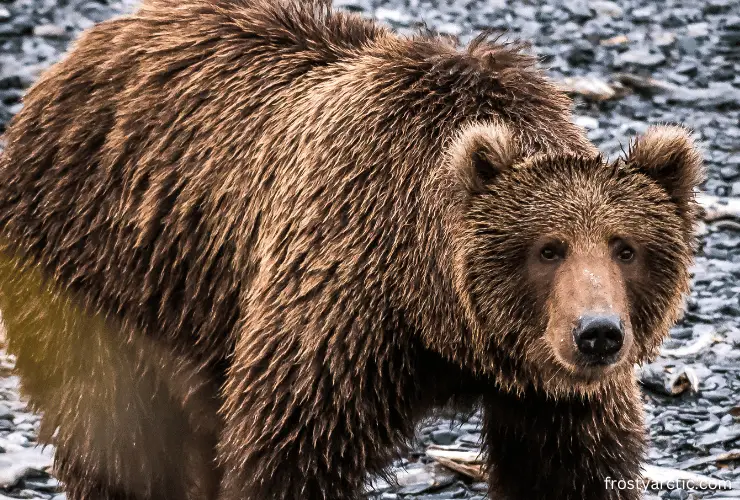
Kodiak bears, like Polar bears, are large. Adult males can weigh between 1000 to 1500 lbs and measure almost 7.5 to 10 feet long.
Their fur varies from blonde to orange to dark brown, helping them blend into their surroundings.
They have a distinctly large, round head, wide-set eyes, and a relatively short, stout body structure.
Unlike Polar bears, Kodiak bears have a dish-shaped face with a pronounced shoulder hump due to their powerful forelimbs. ~Source
| Physical Features | Polar Bear | Kodiak Bear |
| Weight | 900 – 1600 lbs | 1000 – 1500 lbs |
| Length | 8 – 10 feet | 7.5 – 10 feet |
| Fur Color | Appears white (but is actually transparent) | Varies from blonde to orange to dark brown |
| Body Shape | Long and lean body | Short and stout body |
| Special Features | Large, paddle-like paws | Pronounced shoulder hump |
4. Diet and Feeding Habits
Polar Bear sticks to a high-fat diet, whereas the Kodiak Bear enjoys a more varied diet.
Polar Bear
When it comes to dining, Polar Bears are specialists. They’ve got a taste for fatty things.
They are hypercarnivores, meaning their diet comprises more than 70% meat. In their case, it’s mostly marine mammals, as detailed in the book Encyclopedia of Marine Mammals (Third Edition).
Their favorite meal? Ringed and bearded seals.
They use the sea ice as a platform to hunt these seals, waiting patiently at seal breathing holes or breaking into seal dens to catch their prey.
They also have a remarkable behavior known as ‘stalking,’ where they remain still and silent, waiting for the perfect moment to pounce on unsuspecting seals.
While seals are their primary food source, they are open to switching things up. They’ve been known to eat
- Birds and their eggs
- Vegetation
- Rodents
- Shellfish
- Crabs
- Walrus
- Beluga whales.
They even eat scavenged whale carcasses when the opportunity presents itself.
Kodiak Bear
Unlike their Arctic cousins, Kodiak Bears are more versatile in their dietary preferences. They are omnivores, so they eat both plants and meat.
They love their salmon. Kodiak Bears feast on these fish, especially during the annual salmon run.
Beyond fish, Kodiak Bears also munch on
- Berries
- Plants
- Small mammals
- Invertebrates
- Birds and their eggs
- Rodents.
They’re not picky eaters!
Interestingly, Kodiak Bears also exhibit a behavior known as “high-grading.” They will often eat only salmon’s skin, brain, and roe, which are the fattiest parts, especially when food is abundant.
| Aspect | Polar Bear | Kodiak Bear |
| Diet Type | Hypercarnivores (70% meat) | Omnivores (64% salmon) |
| Primary Food | Ringed and bearded seals, birds, eggs, vegetation, rodents, shellfish, crabs, walrus, beluga whales, and whale carcasses | Salmon, berries, plants, small mammals, invertebrates, rodents, birds and eggs |
| Hunting Style | Use sea ice as a platform to hunt seals | Feast during the annual salmon run and forage for berries and plants |
| Feeding Habits | High-fat diet to sustain in the Arctic conditions | High-grading – eat only the fattiest parts of salmon when food is abundant |
5. Social Behavior
Both these bears exhibit unique social behaviors that are adapted to their respective environments.
Polar Bear
Polar Bears are often considered solitary creatures, and for the most part, they are. However, they have some social behaviors that may surprise you.
Adult males occasionally form temporary friendships with each other, particularly in summer when they’re not competing for mates or food.
During mating season, males can become quite aggressive as they compete for females.
Mothers are extremely protective of their cubs and usually keep them close for about 2.5 years, teaching them how to survive in the harsh Arctic.
Kodiak Bear
On the other side, Kodiak Bears have a slightly more sociable lifestyle.
Kodiak Bears are generally solitary, but you’ll often see them gather in large numbers at prime fishing spots during the salmon run.
They have a dominance hierarchy, especially among males, based on size, age, and temperament. This helps reduce fighting over fishing spots or potential mates.
Like Polar Bears, Kodiak bear mothers keep their cubs close for about three years, during which they learn the necessary survival skills, as described by the Alaska Department of Fish and Game.
| Behavior | Polar Bear | Kodiak Bear |
| Typical Behavior | Mostly solitary, but sometimes form temporary friendships | Mostly solitary, but gather in groups during salmon run |
| Mating Behavior | Males can become aggressive during mating season | Dominance hierarchy based on size, age, and temperament |
| Parenting | Mother keeps cubs for ~2.5 years | Mother keeps cubs for ~3 years. |
6. Reproduction and Lifecycle
As with everything else, Polar Bears and Kodiak Bears have their own unique ways of expanding their family tree.
Polar Bear
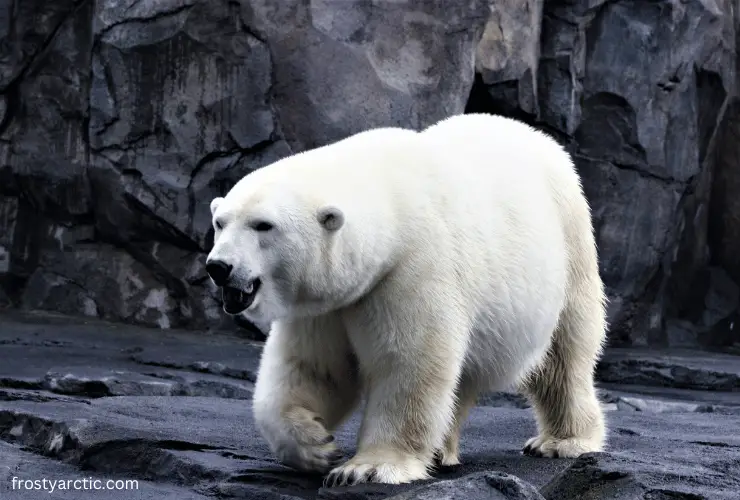
Mating occurs from March to May, with most cubs born around December.
Here’s a fun fact: Polar bears undergo “delayed implantation.” It means the fertilized egg does not immediately implant in the uterus but waits until environmental conditions are right.
Pregnant females dig dens in the snow where they hibernate, give birth to typically one to two cubs, and nurse them until the outside conditions are favorable.
Polar bears can live around 20-30 years in the wild. But only a few reach old age due to the harsh conditions in their environment.
Kodiak Bear
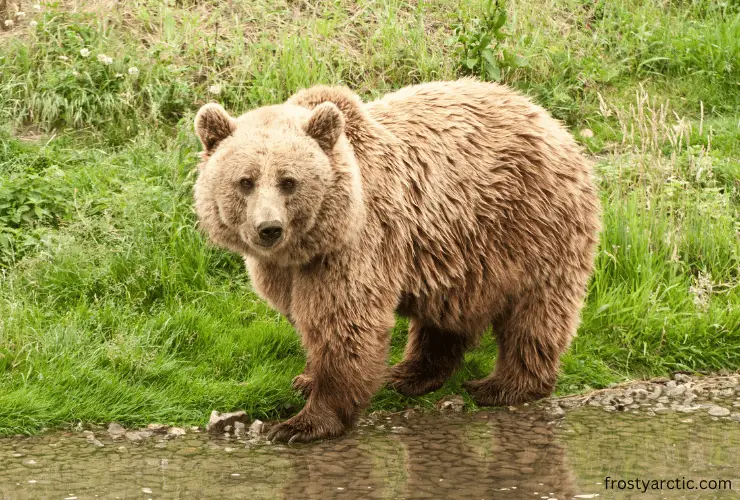
Mating season takes place from May to July. However, due to delayed implantation (yes, Kodiak Bears have it, too!), the fertilized eggs only develop once the mother begins hibernation.
Cubs are usually born during hibernation in January or February. The mother gives birth to a litter of one to four cubs (typically two), which are extremely small at birth.
Like Polar Bears, Kodiak Bear mothers keep their cubs close for about three years, teaching them the ins and outs of bear life.
These brown bears can live around 20 -30 years in the wild.
| Reproduction | Polar Bear | Kodiak Bear |
| Mating Season | April to June | May to July |
| Cubs Born | November to January | January to February (during hibernation) |
| No of Cubs per Litter | Typically 1-2 | Usually 2-3 |
| Unique Features | Delayed implantation; dens in snow for birthing and nursing | Delayed implantation; Cubs born during hibernation |
| Parenting | Mother stays with cubs for ~2.5 years | Mother stays with cubs for ~3 years |
| Lifespan | 20-30 years | 20-30 years |
7. Natural Predators
Polar bears and Kodiak bears are the largest predators. However, young and weak individuals do face some threats.
Polar Bear
Adult Polar Bears are at the top of the food chain in the Arctic and have no natural predators. Their biggest threats come from other Polar Bears in territorial disputes or fights over mates.
However, Polar Bear cubs are vulnerable. While the mother protects them ferociously, they can be at risk from other adult Polar Bears and occasionally Arctic foxes and Wolves, as detailed in a report by COSEWIC.
Kodiak Bear
Similar to the Polar Bear, adult Kodiak Bears also sit at the top of the food chain with no natural predators.
The cubs, however, can fall prey to other adult Kodiak Bears, wolves, or foxes if they stray too far from their mothers.
| Aspect | Polar Bear | Kodiak Bear |
| Natural Predators for Adults | None | None |
| Threats to Cubs | Other Polar Bears and occasionally Arctic foxes and Wolves | Other Kodiak Bears, wolves, and foxes |
8. Defense Mechanism
When it comes down to defense mechanisms, both the Polar and Kodiak Bears rely on their sheer size and strength and the power of their claws and jaws. But each also has a unique trick to fight off their predators.
Polar Bear
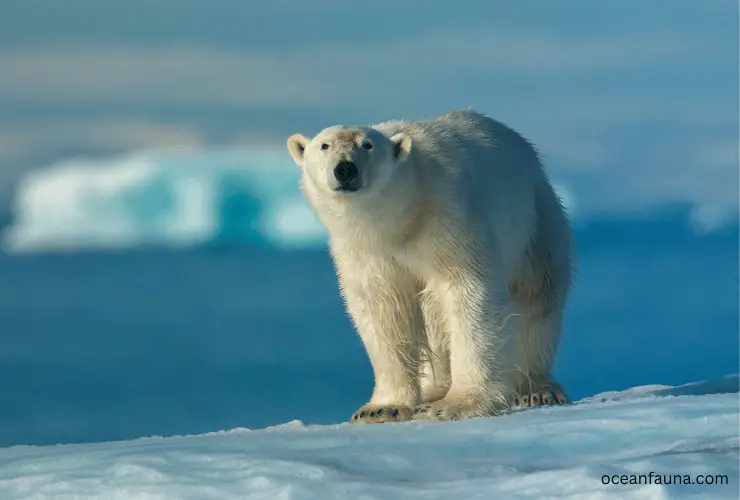
Polar Bears, the largest land predator, have several impressive defense mechanisms.
Their sheer size and strength are often enough to deter potential threats. They often stand on their hind legs to appear even larger when they perceive a threat. They might charge or roar to intimidate the intruder if the threat persists.
These mighty bears are equipped with powerful forelimbs and sharp claws that they can use to swipe at attackers and strong jaws that can deliver a deadly bite.
However, polar bears are generally more likely to flee than fight unless they are defending their cubs or a food source.
Kodiak Bear
Likewise, the Kodiak Bear’s defense mechanisms are a testament to its standing as a dominant force in the animal kingdom.
Size and strength are also major assets for the Kodiak Bear. Their powerful forelimbs, sharp claws, and strong jaws are formidable defensive tools.
They may also use vocalizations and body language to warn off potential threats. A standing Kodiak Bear is a sight that could make any predator think twice!
| Defense Mechanism | Polar Bear | Kodiak Bear |
| Physical Defense | Size, strength, powerful forelimbs, sharp claws, and strong jaws | Size, strength, powerful forelimbs, sharp claws, and strong jaws |
| Behavioral Defense | Standing on hind legs to appear larger, fleeing, charging, and roaring | Vocalizations and body language to warn of threats |
9. Interaction With Humans
Each species also has unique behavior patterns in response to human presence.
Polar Bear
Polar Bears and humans have a complex relationship shaped by centuries of interaction.
Polar Bears tend to avoid humans, but climate change has made food scarcer in the Arctic, leading to more encounters. These meetings can be dangerous because hungry Polar Bears may see humans as potential prey.
Native Arctic people have hunted Polar Bears for thousands of years for their meat and fur. This practice continues in some areas today, as described by Animal Diversity Web.
Polar Bear tourism has grown in recent years, with tourists traveling to the Arctic to see these animals in the wild.
Kodiak Bear
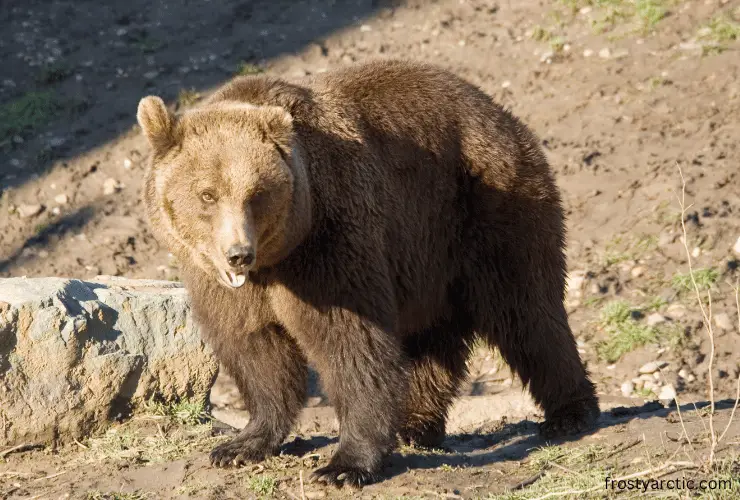
Over in Alaska, Kodiak Bears have their own history with humans.
Kodiak Bears and humans have coexisted on the Kodiak Archipelago for about 7,000 years. The bears mostly avoid people but can pose a danger if surprised or if a mother feels her cubs are threatened.
Alutiiq Natives hunted Kodiak Bears for their meat, fat, and hides while viewing them with respect and spiritual reverence.
Like Polar Bears, tourism centered around Kodiak Bears is popular, with many people visiting the Kodiak National Wildlife Refuge to see these magnificent creatures.
| Aspect | Polar Bear | Kodiak Bear |
| Interaction With Humans | Generally avoid humans, but encounters have increased due to climate change | Have coexisted with humans for about 7,000 years, mostly avoid humans |
| Threats to Humans | Can be dangerous, especially when food is scarce | Can pose a danger if surprised or if a mother bear feels her cubs are threatened |
| Hunting by Humans | Hunted for meat and fur by Arctic Natives | Hunted for meat, fat, and hides by Alutiiq Natives |
| Tourism | Polar Bear tourism is popular, with tourists traveling to the Arctic | Many tourists visit the Kodiak National Wildlife Refuge to see Kodiak Bears |
10. Threats and Conservation Status
As with everything else, Polar Bears and Kodiak Bears face different challenges.
Polar Bear
Sadly, the biggest threat to Polar Bears is climate change.
Polar Bears depend on sea ice to hunt, and with the Arctic warming twice as fast as the rest of the planet, sea ice is disappearing rapidly. This makes it harder for them to find food and can lead to starvation.
Besides climate change, they also face threats from oil and gas extraction in the Arctic, which can lead to habitat destruction and pollution.
According to the IUCN, Polar Bears are listed as Vulnerable, with a high risk of extinction in the wild.
Kodiak Bear
Kodiak Bears face different threats, but there’s some good news too!
Historically, overhunting was a serious threat to Kodiak Bears. However, conservation measures have helped the population recover.
Today, their biggest threats come from habitat loss due to logging and development and conflicts with humans as both populations expand.
According to the IUCN, Kodiak Bears (classified as a population of the Brown Bear) are listed as Least Concern.
| Aspect | Polar Bear | Kodiak Bear |
| Major Threats | Climate change, oil and gas extraction | Habitat loss, conflicts with humans |
| Historical Threats | Overhunting | Overhunting |
| IUCN Status | Vulnerable | Least Concern (as part of Brown Bear population) |
11. Polar Bear vs Kodiak Bear: Who Would Win a Fight?
Now, imagine a face-off between a Kodiak Bear and a Polar Bear. Who do you think would win?
The Kodiak Bear has the strongest forelimbs of any terrestrial predator. Its claws, longer and deadlier than Polar Bear’s, can deliver knockout swipes. With canines matching the size of Polar Bears and a bite force of 1,300 PSI (Polar Bears are slightly behind with 1,200 PSI), the Kodiak is not to be underestimated!
But the real trump card? Stamina.
Sure, Polar Bears can swim for miles in icy waters without tiring, but it’s a whole different story on land. Their thick fur and fat layers that keep them warm in the Arctic can cause them to overheat quickly during a land-based brawl.
So, in a fight between the Kodiak bear and the polar bear, it seems the polar bear would likely retreat to save itself. The Kodiak bear, being almost the same size, stronger, and having far better stamina on land, would likely come out on top.
Watch the video here:
Wrapping Up
So, are Polar Bears and Kodiak Bears the same? Absolutely not! While they share a family tree and some characteristics, they each have unique attributes and adaptations that make them special.
Polar Bears, adapted for life in the Arctic, primarily prey on seals. They are also known for their striking white fur, which serves as camouflage in the snowy Arctic environment and helps to conserve heat.
In contrast, Kodiak Bears, native to the Alaskan wilderness, enjoy a varied diet. Their fur ranges from blond to dark brown, providing an ideal cover in their forested surroundings.
We hope this blog has deepened your understanding of our planet’s stunning variety of life. Don’t forget to check back for more captivating creature comparisons!

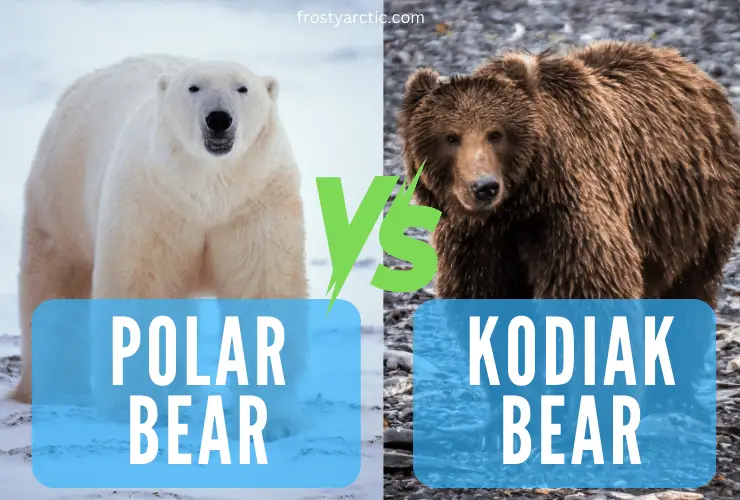

2 thoughts on “Polar Bear vs Kodiak Bear: 11 Key Differences Explained”